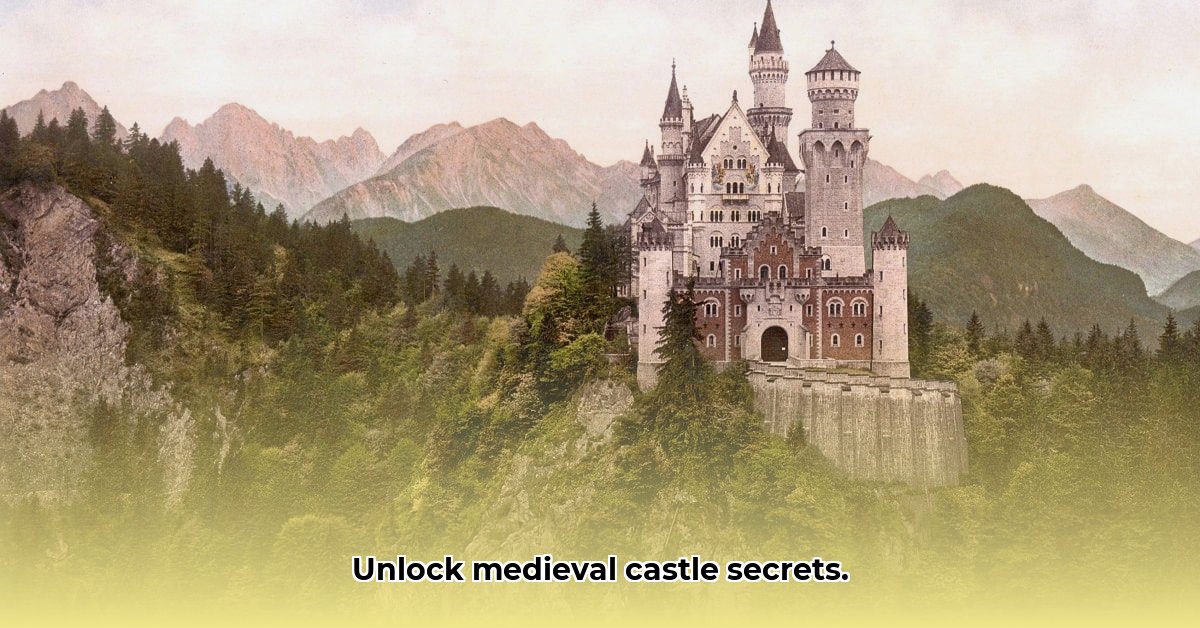
Medieval Castle Architecture History: A Journey Through Time
Let's embark on a journey through the captivating history of medieval castle architecture. This isn't just a story of stone and mortar; it's a narrative woven from warfare, societal shifts, and ingenious engineering. We'll trace the evolution of these mighty structures, from humble beginnings to complex fortresses, revealing how technology and social changes shaped their design. Did you know that the design of a medieval castle could vary drastically based on its geographic location and the resources available to its builders? We'll explore these fascinating variations and more. For even more castle design inspiration, check out these castle designs.
From Humble Beginnings: Motte-and-Bailey Castles and Their Predecessors
Imagine a time before grand stone castles. Early defenses were rudimentary – simple wooden palisades offering minimal protection. Constant warfare demanded better protection, leading to the motte-and-bailey design: a tall mound of earth (the "motte") crowned with a wooden tower, and a lower, enclosed courtyard (the "bailey"). A ditch and fence enhanced security. Their simplicity was their strength; these castles were inexpensive and quickly constructed, providing a crucial defensive advantage in a world of frequent skirmishes. However, their vulnerability to prolonged sieges highlighted the need for improvement.
The Norman Impact: Stone Castles and Strategic Advances
The Norman Conquest of 1066 proved pivotal. Norman military engineers revolutionized castle design, replacing wood with stone. This shift dramatically increased castle strength and resilience. The concentric castle emerged, featuring multiple layered walls, strategically placed towers, fortified gates, and deep moats. This multi-layered defense system represented a significant leap in defensive capabilities and was indicative of the resources and engineering expertise at the Normans' disposal. Why the change to stone? It was simply harder to breach during a siege – a significant advantage in warfare.
Architectural Marvels: Keeps, Curtain Walls, and Strategic Placement
The keep, a central tower, served multiple purposes. It was the ultimate last defensive stand, a powerful symbol of authority, and the lord's residence. Impressive curtain walls (continuous walls) connected strategically placed towers, creating a formidable defensive perimeter. Castle placement wasn't arbitrary: builders exploited natural features like hills and rivers to maximize their defenses. The positioning of towers and walls was meticulously planned, securing protection from all angles. This level of strategic planning demonstrates the immense effort and foresight involved in constructing these magnificent structures.
Regional Variations: A Tapestry of Styles
Medieval castle architecture wasn't uniform. Regional differences arose due to geography, available resources, and local building traditions. For example, English castles often featured concentric layouts with prominent keeps, whereas French castle designs reflected the varied terrain, showcasing the creativity of their builders in adapting to local landscapes. These regional variations highlight the adaptability and ingenuity of medieval builders who tailored their designs to suit unique environmental challenges.
Beyond Battlements: Living, Governing, and Displaying Power
Over time, castles evolved beyond military functions. They became administrative centers, luxurious residences, and symbols of power. Architectural additions included grand halls, comfortable private chambers, and chapels, transforming these structures from mere fortresses into grand residences and hubs of local governance. This evolution reflects the changing priorities of rulers, where comfort and opulence became as paramount as defense. How did this affect the overall design and construction? It led to the incorporation of more ornate and luxurious features.
The Decline and Enduring Legacy
The advent of gunpowder weaponry in the late medieval period marked a turning point. Cannon fire easily breached even the strongest stone walls, rendering many castles obsolete. Nevertheless, their legacy endures. Majestic ruins stand as powerful reminders of the past, attracting tourists, inspiring artists and architects, and serving as invaluable sources of historical information. They offer a window into the technology, social structures, and artistic sensibilities of medieval societies.
Key Takeaways: Three Pivotal Points in Medieval Castle Evolution
- The transition from wood to stone: This marked a significant increase in defensive capabilities and architectural sophistication.
- The development of concentric castle designs: Multiple layers of defense greatly enhanced security and prolonged sieges.
- The evolution of castles into centers of administration and residential life: This demonstrates the adaptability and expanding societal roles of these structures.
How to Understand Medieval Castle Construction Costs and Timelines
Estimating medieval castle construction costs and timelines is complex, due to limitations in historical records. However, analysis of surviving accounts reveals valuable insights. Edward I's expenditure on his Welsh castles (Harlech, Conway, and Caernarfon) provides valuable data points, though these only reflect royal outlays. To refine cost estimations, we must consider several crucial factors:
- Labor Costs: Unskilled laborers earned far less than skilled craftsmen, especially master masons, whose expertise commanded high wages.
- Material Costs: The cost and availability of materials varied significantly; locally sourced stone was cheaper than imported materials.
- Construction Time: Projects spanned years, even decades, impacting labor costs and overheads.
The construction of a medieval castle was a monumental undertaking, requiring immense resources, skilled labor, and comprehensive planning, a testament to the engineering prowess and ambition of medieval societies. Their enduring legacy continues to fascinate and inspire.